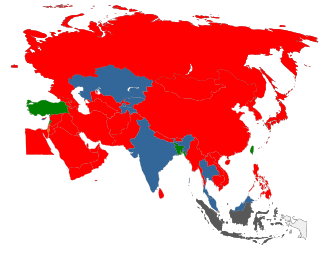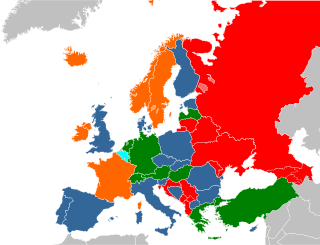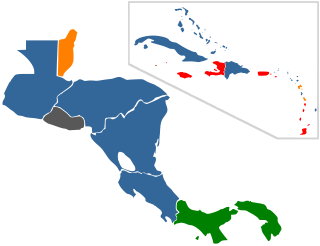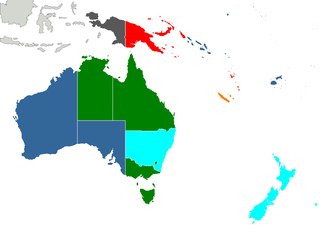Related Research Articles
Child sex tourism (CST) is tourism for the purpose of engaging in the prostitution of children, which is commercially facilitated child sexual abuse. The definition of child in the United Nations Convention on the Rights of the Child is "every human being below the age of 18 years". Child sex tourism results in both mental and physical consequences for the exploited children, which may include sexually transmitted infections, "drug addiction, pregnancy, malnutrition, social ostracism, and death", according to the State Department of the United States. Child sex tourism, part of the multibillion-dollar global sex tourism industry, is a form of child prostitution within the wider issue of commercial sexual exploitation of children. Child sex tourism victimizes approximately 2 million children around the world. The children who perform as prostitutes in the child sex tourism trade often have been lured or abducted into sexual slavery.
Prostitution in Belize is legal, but the buying of sexual services is not. Associated activities such as operating a brothel, loitering for the purposes of prostitution and soliciting sex are also illegal.

Prostitution in Pakistan is a taboo culture of sex-trade that exists as an open secret but illegal. Prostitution is largely based in organisational setups like brothels or furthered by individual call girls.
Prostitution in Panama is legal and regulated. Prostitutes are required to register and carry identification cards. However, the majority of prostitutes are not registered. There are 2,650 sex workers registered with the government in 2008, but there was no accurate information regarding the total number of persons practising prostitution in the country. Some estimate put the number of unregistered prostitutes at 4,000.

Prostitution is legal and regulated in Bangladesh. Prostitutes must register and state an affidavit stating that they are entering prostitution of their own free choice and that they are unable to find any other work. Bangladeshi prostitutes often suffer poor social conditions and are frequently socially degraded.
Prostitution is not illegal in Sri Lanka, however, related activities such as soliciting, procuring, and brothels are outlawed. It is also illegal to traffic persons for prostitution, especially minors. Prostitution is not as widespread in Sri Lanka as in some neighbouring countries. It is estimated that there are 40,000 prostitutes in the country, and nearly half of them operate in Colombo.
Prostitution is illegal in Egypt. The Egyptian National Police officially combats prostitution but, like almost all other countries, prostitution exists in Egypt. UNAIDS estimate there to be 23,000 prostitutes in the country, including Egyptians, West African and Eastern Europeans.
Prostitution is illegal in Qatar and carries severe punishment of several years in prison. Prostitution normally takes place in bars, nightclubs and hotels. There are occasional clamp-downs and the prostitutes are arrested and deported.
Prostitution in Cyprus is not illegal, but operating brothels, organising prostitution rings, living off the profits of prostitution, encouraging prostitution or forcing a person to engage in prostitution are illegal activities.

The legality of prostitution in Europe varies by country.
Prostitution in Azerbaijan is illegal but common. Prostitution is an administrative offence and punishable by a fine. Keeping a brothel is a criminal offence and punishable by up to 6 years' imprisonment. In 2017 a draft law proposing to add heavy fines to the punishment for keeping a brothel was before the National Assembly. It has been estimated that there are 25,054 prostitutes in Azerbaijan, some of which are aged 15 to 18.
Prostitution in Guyana is illegal but widespread. Prostitution law is antiquated and dates from the colonial era. Law enforcement is inconsistent and sex workers report violence and abuse by the police. Many turn to prostitution for economic reasons and the lack of other job opportunities. Prostitution continues to receive greater public attention due to the high incidence of HIV/AIDS among prostitutes. Prostitution in the country is separated into three types: "uptown", servicing affluent clients, "downtown", servicing the working classes, and mining sites. UNAIDS estimate there to be 6,000 prostitutes in the country.

Prostitution in Malta is itself legal, but certain activities connected with it, such as running a brothel and loitering, are not. Certain offences are punishable by sentences of up to two years in prison. In March 2008, police and the Malta Ministry for Social Policy signed a memorandum of understanding to formalize a screening process for all arrested persons engaged in prostitution to determine whether they were victims of trafficking or other abuses. The law provides punishments of up to 6 years for involving minors in prostitution.
Prostitution in Croatia is illegal but common. Forcible prostitution, any kind of brothels, or procuring are treated as a felony, while voluntary prostitution is considered to be infraction against public order. Like in many other Southeast European countries, the problem of human trafficking for the purposes of sex is big in Croatia.
Prostitution in Rwanda is illegal in all aspects. Prostitutes, clients and any involved third parties are criminalised by the country's Penal Code. However, a draft of a new Penal Code that does not prohibit prostitution was presented for debate in the Rwandan Parliament in December 2017.
Prostitution in Namibia is legal and a highly prevalent common practice. Related activities such as solicitation, procuring and being involved in the running of a brothel are illegal. A World Bank study estimated there were about 11,000 prostitutes in Namibia.
Barbados is a source and destination country for men, women, and children subjected to trafficking in persons, specifically forced prostitution and forced labor. Some children in Barbados are subjected to commercial sexual exploitation in “transactional sex” wherein a third party such as a parent receives a benefit from the child's participation in sexual activity. Researchers identified patterns of transactional sex within families, most often by adult male caretakers such as step-fathers, as well as child prostitution outside the home. Women from the Dominican Republic, Guyana, and Jamaica voluntarily enter Barbados as illegal migrants, and some expect to engage in prostitution. Some of these women are exploited in forced prostitution subsequent to their arrival. Some other foreign women who entered the country illegally are exploited in involuntary domestic servitude in private homes. Foreign men have been transported to Barbados for the purpose of labor exploitation in construction and other sectors. Sex traffickers, primarily organized criminals from Guyana, form partnerships with pimps and brothel owners from Trinidad and Tobago and Barbados, and lure women to Barbados with offers of legitimate work. Trafficking victims tend to enter the country through legal means, usually by air; traffickers later use force and coercion to obtain and maintain the victims' work in strip clubs, massage parlors, some private residences, and “entertainment clubs” which operate as brothels. Traffickers use methods such as threats of physical harm or deportation, debt bondage, false contracts, psychological abuse, and confinement to force victims to work in construction, the garment industry, agriculture, or private households.
Prostitution in Tajikistan is legal, but related activities such as soliciting, procuring and brothel keeping are prohibited. Prostitution has increased within the country since the collapse of the Soviet Union. UNAIDS estimate there are 14,100 female sex workers in Tajikistan. Government official figures for 2015 were 1,777 prostitutes and 194 brothels. Prostitution occurs on the streets and in bars, restaurants, nightclubs and saunas, and HIV prevalence is 3.5% amongst sex workers.

Legality of prostitution in the Americas varies by country. Most countries only legalized prostitution, with the act of exchanging money for sexual services legal. The level of enforcement varies by country. One country, the United States, is unique as legality of prostitution is not the responsibility of the federal government, but rather state, territorial, and federal district's responsibility.

Prostitution in Oceania varies greatly across the region. In American Samoa, for instance, prostitution is illegal, whereas in New Zealand most aspects of the trade are decriminalised.
References
- ↑ "Sex Work Law". Sexuality, Poverty and Law. Retrieved 3 January 2018.
- 1 2 "Laws of Trinidad and Tobago : Sexual Offences Act : Chapter 11:28 : Act 27 of 1986" (PDF). Rgd.legalaffairs.gov.tt. 31 December 2015. Retrieved 2017-01-11.
- ↑ "Women trafficked for prostitution and forced marriage in Trinidad - Caribbean360". 24 January 2014. Retrieved 11 January 2017.
- 1 2 "Trinidad and Tobago: Child Prostitution Is A Thriving Business - Inter Press Service" . Retrieved 11 January 2017.
- ↑ Brown, John (15 February 2011). "What about street prostitutes, Louis?". The Trinidad Guardian Newspaper. Retrieved 4 January 2018.
- 1 2 3 "Trinidad and Tobago 2016 Trafficking in Persons Report". U.S. Department of State. Retrieved 3 January 2018.
- 1 2 3 4 5 Pope, Cynthia; White, Renée T.; Malow, Robert (2009). HIV/AIDS : global frontiers in prevention/intervention. New York, NY: Routledge. ISBN 978-0415953832.
- 1 2 3 Fido, Austin (20 September 2015). "The shady side of paradise". Trinidad & Tobago Guardian. Retrieved 23 December 2017.
- 1 2 3 Gibbings, Wesley (24 March 1997). "The High Cost of Sex Tourism". IPS News. Retrieved 4 January 2018.
- 1 2 Niblett, Michael; Campbell, Chris (31 May 2016). The Caribbean: Aesthetics, World-Ecology, Politics (Postcolonialism Across the Disciplines). Liverpool University Press. ISBN 978-1781382950.
- ↑ "16 Caribbean Nations Where Sex Trafficking Remains A Problem | News Americas Now:Caribbean and Latin America Daily News". News Americas Now. 30 June 2016. Retrieved 30 December 2017.
- ↑ "Laws of Trinidad and Tobago: Summary Offences Act Chapter 11:02" (PDF). Government of Trinidad and Tobago. 1921. Retrieved 3 January 2018.
- 1 2 3 4 5 6 7 Connelly, Corey (12 July 2015). "100 Arrivals Weekly". Trinidad and Tobago Newsday. Retrieved 3 January 2018.
- 1 2 3 4 5 6 7 8 9 Trotman, David Vincent (1986). Crime in Trinidad : conflict and control in a plantation society, 1838-1900 (1st ed.). Knoxville, TN: University of Tennessee Press. ISBN 978-0870494918.
- 1 2 3 4 Brereton, Bridget (2002). Race relations in colonial Trinidad, 1870-1900 (Paperback ed.). Cambridge: Cambridge University Press. ISBN 978-0521523134.
- 1 2 3 "'Tis the season for prostitution?". The Trinidad Express. 19 February 2011. Retrieved 4 January 2018.
- 1 2 MacDonald, Scott B. (1 January 1986). Trinidad and Tobago: Democracy and Development in the Caribbean. ABC-CLIO. ISBN 9780275920043 . Retrieved 11 January 2017– via Google Books.
- ↑ Brereton, Bridget (20 November 2013). "Women in wartime". The Trinidad Express. Retrieved 4 January 2018.
- 1 2 3 "Trinidad And Tobago By World War II History Essay". UK Essays. 23 March 2015. Retrieved 4 January 2018.
- 1 2 Brereton, Bridget (1 January 1996). An Introduction to the History of Trinidad and Tobago. Heinemann. ISBN 9780435984748 . Retrieved 11 January 2017– via Google Books.
- 1 2 3 McCollin, Debbie (April 2010). "Friend or foe? Venereal diseases and the American presence in Trinidad and Tobago during World WarII" (PDF). The University of the West Indies. Retrieved 4 January 2018.
- ↑ Chaguaramas History at the Chaguaramas Development Authority Archived August 20, 2008, at the Wayback Machine
- 1 2 3 "Trinidad and Tobago 2017 Trafficking in Persons Report". U.S. Department of State. Archived from the original on 3 July 2017. Retrieved 3 January 2018.
 This article incorporates text from this source, which is in the public domain .
This article incorporates text from this source, which is in the public domain . - 1 2 Wilson, Sascha (16 March 2016). "Cop to stand trial on 13 charges of human trafficking". The Trinidad Guardian Newspaper. Retrieved 3 January 2018.
- ↑ Daye, Marcella; Chambers, Donna; Roberts, Sherma (2011). New perspectives in Caribbean tourism (Reprint ed.). London: Routledge. ISBN 978-0415897860.
- ↑ Fox, Lauren R.D. (8 April 2016). "Issa Rae's #ShortFilmSundays Presents "The Resort," An Exposé On Sex Tourism". Madame Noir. Retrieved 23 December 2017.